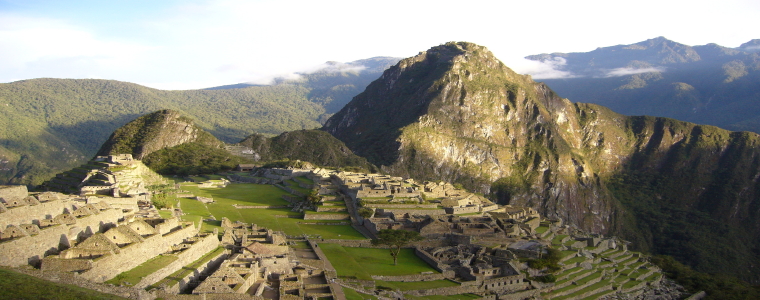|
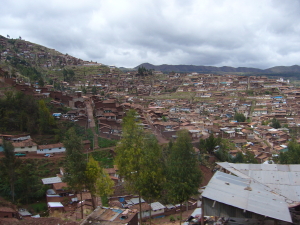 Cusco
is the oldest continuously inhabited city in the Western Hemisphere
and was the capital of the Incas. It has a population of over 400,000
people, many of whom live in the highlands surrounding the city
center. At over 11,000 ft, altitude sickness is a common problem
for tourists visiting the area. By the time we arrived in Cusco,
we had somewhat adjusted to the altitude after visiting the Urumbamba
Valley and Machu Picchu which were only at 7-9000 ft above sea level.
Also, it was suggested we drink coca tea or suck on coca candies
or the coca leaves. Coca leaves comes from the same plant that produces
cocaine. It did seem to help as only a few of our group developed
altitude problems. Cusco
is the oldest continuously inhabited city in the Western Hemisphere
and was the capital of the Incas. It has a population of over 400,000
people, many of whom live in the highlands surrounding the city
center. At over 11,000 ft, altitude sickness is a common problem
for tourists visiting the area. By the time we arrived in Cusco,
we had somewhat adjusted to the altitude after visiting the Urumbamba
Valley and Machu Picchu which were only at 7-9000 ft above sea level.
Also, it was suggested we drink coca tea or suck on coca candies
or the coca leaves. Coca leaves comes from the same plant that produces
cocaine. It did seem to help as only a few of our group developed
altitude problems. 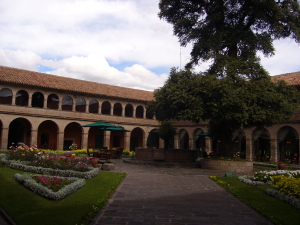 We
stayed at the Monasterio Hotel which was built in 1592 as a seminary
to train Catholic priests. It was turned into a hotel in 1965 and
is run by the Orient Express. Unfortunately, the very beautiful
chapel was closed to visitors due to a seminary meeting. The Monasterio
offers piped in oxygen to the rooms and some of our group said it
helped them sleep. I guess we are more accustomed to the thinner
air as we live at 8,000 ft in Colorado. We
stayed at the Monasterio Hotel which was built in 1592 as a seminary
to train Catholic priests. It was turned into a hotel in 1965 and
is run by the Orient Express. Unfortunately, the very beautiful
chapel was closed to visitors due to a seminary meeting. The Monasterio
offers piped in oxygen to the rooms and some of our group said it
helped them sleep. I guess we are more accustomed to the thinner
air as we live at 8,000 ft in Colorado.
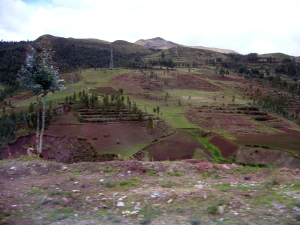 The
main occupation in Cusco is copper mining and agriculture. In the
highlands the main crop is potatoes and fava beans. They grow over
300 varieties of potatoes. Guinea pigs are raised on the farms to
provide fertilizer for the fields as well as for food (it is on
the menu in restaurants). Land is often communal and families get
parcels at various altitudes. Bulls are used for plowing the fields.
Stairways lead from the city up the hills to the suburbs. The houses
are adobe with tile roofs. The
main occupation in Cusco is copper mining and agriculture. In the
highlands the main crop is potatoes and fava beans. They grow over
300 varieties of potatoes. Guinea pigs are raised on the farms to
provide fertilizer for the fields as well as for food (it is on
the menu in restaurants). Land is often communal and families get
parcels at various altitudes. Bulls are used for plowing the fields.
Stairways lead from the city up the hills to the suburbs. The houses
are adobe with tile roofs.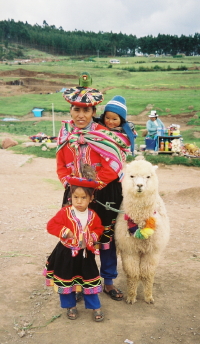 Obviously, the people living in Cusco are very fit.
Obviously, the people living in Cusco are very fit.
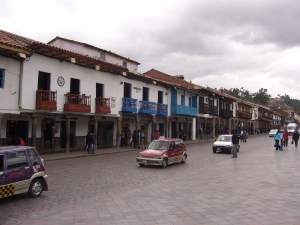 The
city of Cusco is a fascinating mix of Inca and colonial Spanish
architecture. Almost every central street has remains of Inca walls,
arches and doorways. And the perfect Inca stonework now serves as
the foundations for more modern dwellings. The heart of the city,
as in Inca days, is the Plaza de Armas. Around it are colonial arcades
and four churches. The
city of Cusco is a fascinating mix of Inca and colonial Spanish
architecture. Almost every central street has remains of Inca walls,
arches and doorways. And the perfect Inca stonework now serves as
the foundations for more modern dwellings. The heart of the city,
as in Inca days, is the Plaza de Armas. Around it are colonial arcades
and four churches.
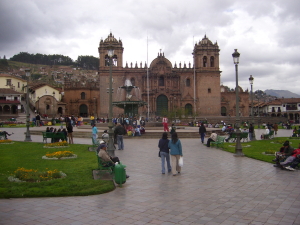 We
visited the main cathedral which is actually 3 churches in one.
The main church in the center was built in the 17th century, while
the 2 churches on either side were built in the 18th century. All
are very ornate and contain over 400 paintings done by local artists.
The natives copied the paintings of the Italian masters but added
some Inca details to them. We
visited the main cathedral which is actually 3 churches in one.
The main church in the center was built in the 17th century, while
the 2 churches on either side were built in the 18th century. All
are very ornate and contain over 400 paintings done by local artists.
The natives copied the paintings of the Italian masters but added
some Inca details to them. 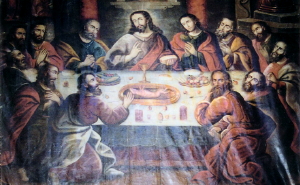 For
example, the Last Supper, as seen on this postcard of the painting,
has a guinea pig in the center of the table (a main course at Inca
feasts) and Pizzaro (the conquerer and betrayer of the Incas) has
replaced Judas at the right end of the table. Angels are often painted
with feathers out of their heads. The choir has full carvings of
all the male saints on the seats, with busts of the female saints
above them and on the arms, naked women in a position for delivering
babies. Mirrors, a holy Inca symbol, can be found on the walls,
even though they were not allowed by the Catholic Church. These
Inca insertions were allowed by the Spanish in order to appease
them and get them to go to the Catholic Church. For
example, the Last Supper, as seen on this postcard of the painting,
has a guinea pig in the center of the table (a main course at Inca
feasts) and Pizzaro (the conquerer and betrayer of the Incas) has
replaced Judas at the right end of the table. Angels are often painted
with feathers out of their heads. The choir has full carvings of
all the male saints on the seats, with busts of the female saints
above them and on the arms, naked women in a position for delivering
babies. Mirrors, a holy Inca symbol, can be found on the walls,
even though they were not allowed by the Catholic Church. These
Inca insertions were allowed by the Spanish in order to appease
them and get them to go to the Catholic Church.
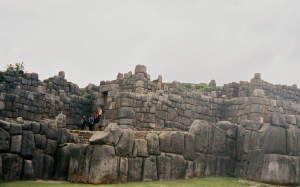 Just
outside the city of Cusco is the Inca fortress of Sacsayhuaman.
This was an Incan place of worship. The limestone walls at this
fortress are hugely impressive; the masive rocks weigh up to 130
tons and are fitted together with absolute perfection. Just
outside the city of Cusco is the Inca fortress of Sacsayhuaman.
This was an Incan place of worship. The limestone walls at this
fortress are hugely impressive; the masive rocks weigh up to 130
tons and are fitted together with absolute perfection.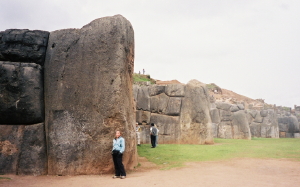 The zig zag walls were built to offer earthquake protection. After
the Spanish conquered the Incas, they pillaged the stones from the
fortress down to Cusco to reuse for their buildings. Silver and
gold idols were melted down and made into coins by the conquering
Spanish Catholics. During recent excavations at the site, a mummy
was found.
The zig zag walls were built to offer earthquake protection. After
the Spanish conquered the Incas, they pillaged the stones from the
fortress down to Cusco to reuse for their buildings. Silver and
gold idols were melted down and made into coins by the conquering
Spanish Catholics. During recent excavations at the site, a mummy
was found.
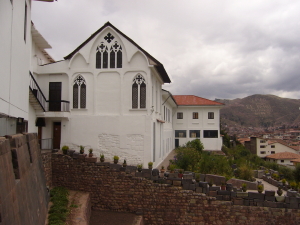 We
visited the Santo Domingo Monastery, built in the 17th century on
top of the walls of the Inca Koricancha Temple of the Sun and from
its stones. We
visited the Santo Domingo Monastery, built in the 17th century on
top of the walls of the Inca Koricancha Temple of the Sun and from
its stones.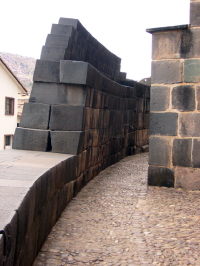 Beneath
one of its cloisters, workers unearthed four of the temple's original
Inca chambers as well as the baths. The walls of this most sacred
Inca sanctuary were stripped of gold by Francisco Pizarro's men
in 1534, its gold artifacts melted down and shipped to Spain. Beneath
one of its cloisters, workers unearthed four of the temple's original
Inca chambers as well as the baths. The walls of this most sacred
Inca sanctuary were stripped of gold by Francisco Pizarro's men
in 1534, its gold artifacts melted down and shipped to Spain.
To view additional photos from the Cusco area, go to Cusco
Photo Gallery.
Home Location
Descriptions Photos Map
Contact Us
|
